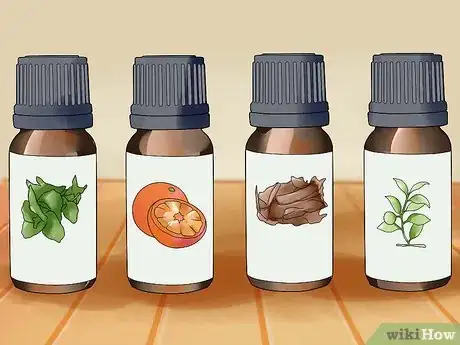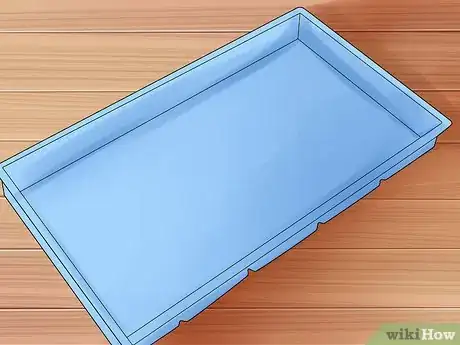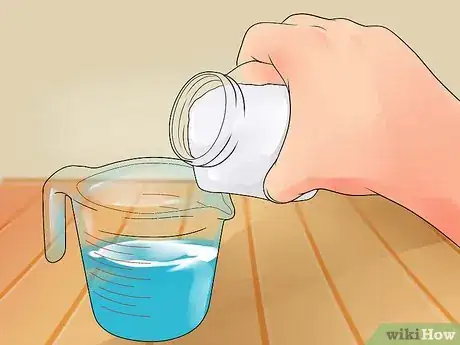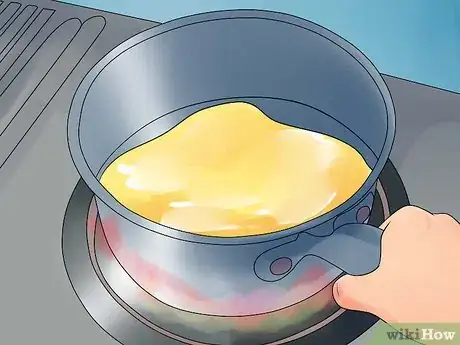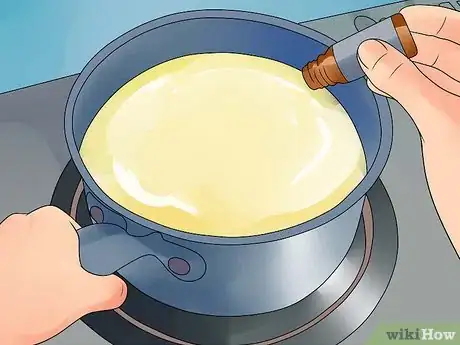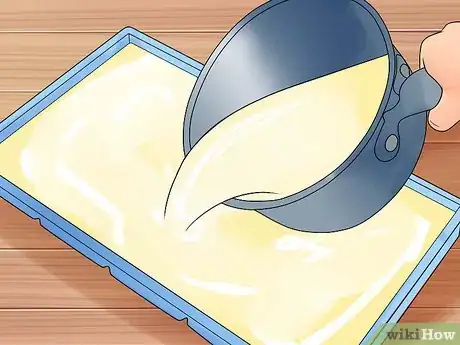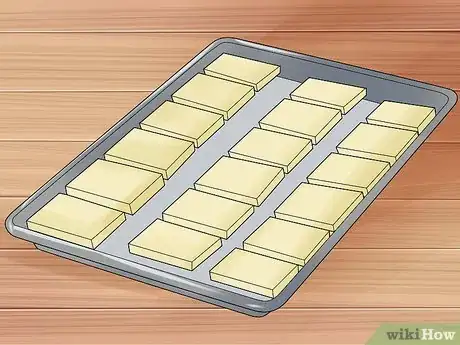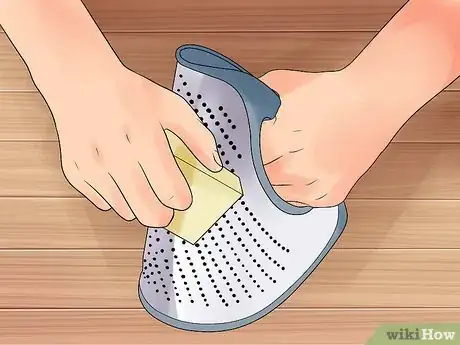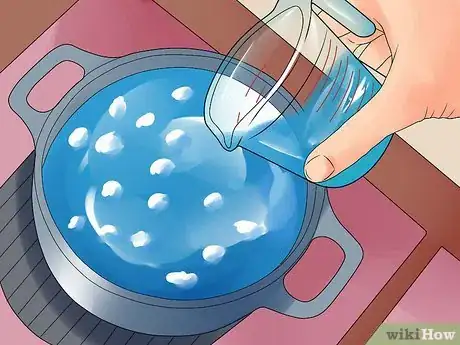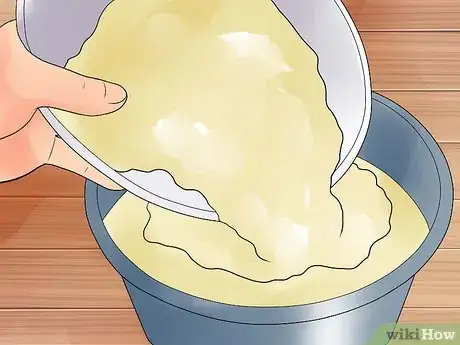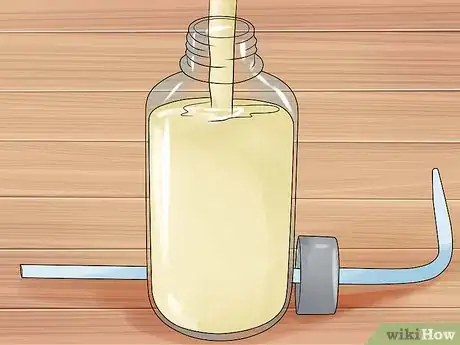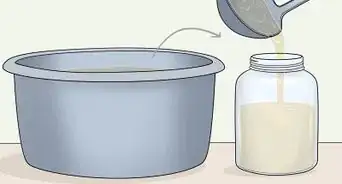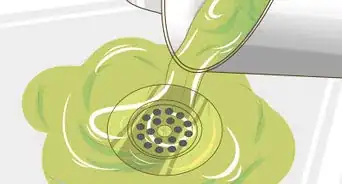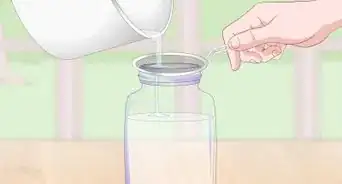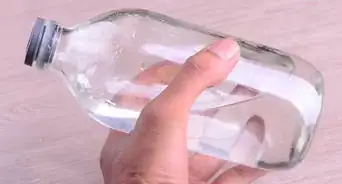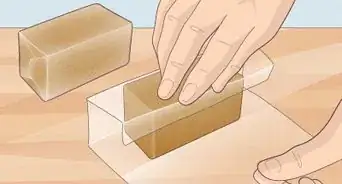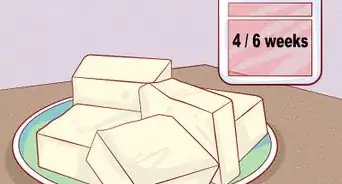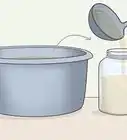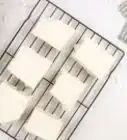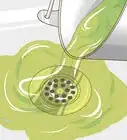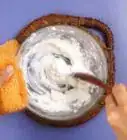wikiHow is a “wiki,” similar to Wikipedia, which means that many of our articles are co-written by multiple authors. To create this article, 14 people, some anonymous, worked to edit and improve it over time.
This article has been viewed 62,769 times.
Learn more...
Castile soap is a biodegradable soap made with olive oil, water and lye. It was invented in Aleppo and brought, by the crusaders, to the Castile region of Spain where it became popular. For centuries people have been using this gentle cleanser for everything from bathing skin and hair to washing clothes and floors. After making bars of Castile soap, you can use them in their solid form or blend them with water to create liquid soap. See Step 1 and beyond to learn how to make your own Castile soap.
Steps
Preparing Soapmaking Supplies
-
1Lay out your equipment. Prepare a work space in your kitchen or near a source of water, and lay out your equipment so everything is at the ready. The bowls, measuring tools and other utensils you use should be reserved for soapmaking only - don't use them when you're making food, since residue from the soap will remain on them. You'll need the following equipment to make Castile soap:
- Large measuring cup
- Stainless steel pot
- Large bowl
- Spatula
- Handheld blender or mixer
- Meat thermometer
- Kitchen scale
- Rubber gloves and safety goggles (for handling lye)
- Lye crystals (these come in plastic containers, and you can store what you don't use; you'll need 4.33 ounces (122.8 grams) to make 10 medium bars of soap)
-
2Prepare your oils. True Castile soap is made with 100 percent olive oil, but many soap makers use a blend of oils to create a soap with balanced properties. Pure olive oil soap has doesn't produce fluffy suds, and it results in soap bars that are a little slimy in texture. Coconut oil is commonly added to help produce better suds, and palm oil helps the soap bars firm up. A ratio of 8 parts olive oil, 1 part coconut oil and 1 part palm oil produces fine soap. For the purposes of this soap recipe, measure out the following oils. You'll end up with a total of 34 ounces (1005.5 milliliters) of oil:
- 27.2 ounces (804.4 milliliters) olive oil
- 3.4 ounces (100.55 milliliters) coconut oil
- 3.4 ounces (100.55 milliliters) palm oil
Advertisement -
3Consider using essential oils. If you want to scent your soap, you'll need 10 drops of your favorite essential oil, or a combination of more than one essential oils amounting to 10 drops. Increase the amount of essential oil you add for a stronger scent, or scale it back to 5 - 7 drops for a milder scent. Common essential oils used in Castile soapmaking include:
- Peppermint
- Orange, lemon or grapefruit
- Lavender
- Rose
- Vetiver
- Pine
- Sandalwood
- Bergamot
-
4Ready your soap mold. The mold you use will determine the size and shape of your finished bars. If you want to make rectangular bars of soap, choose a rectangular soap mold shaped like a loaf pan; the soap will come out in a loaf shape, and you'll be able to cut it into bars as thick as you want. Line the mold with waxed paper so that the soap easily separates from the mold.
- Molds are available at craft and soapmaking supply stores, and you can check online for a large variety of options.
- If you don't want to go to the trouble of buying a mold, you can convert an old shoebox into an adequate soap mold. Just find a sturdy shoebox, reinforce the corners with tape to seal the edges, and line it with waxed paper.
- You can also make your own soap mold using wood, or turn an existing wooden box into a soap mold.[1] The mold should be as wide and deep as you'd like the finished soap bars to be.
Mixing the Lye and Oils
-
1Put on your safety equipment. Lye is a caustic chemical that can burn the skin and eyes and is hard on the lungs when inhaled. If this is your first time working with lye, take extra care to make sure that you handle it safely. Put on your rubber gloves and protective goggles before opening the container of lye. Open some windows and turn on a fan to make sure the room is well ventilated.
- Keep a bottle of white vinegar nearby. If you spill some lye on the counter, the vinegar will neutralize it.
- If you accidentally touch or inhale too much lye, immediately call your country's Poison Control Center phone number, which you can find by doing an online search. The US National Poison Control Center number is 1-800-222-1222.
-
2Make the lye solution. When you mix lye and water, it's important to use exact measurements. For this soap recipe you need 10 ounces (295.7 milliliters) of water and 4.33 ounces (122.8 grams) of lye. Using separate containers, measure out these exact amounts using your kitchen scale. Carefully add the lye to the water. The mixture will immediately begin to heat up and become cloudy, then clear a bit as it cools. It will take several minutes for the mixture to cool. Use the meat thermometer to test the temperature. The lye is ready to use when it reaches 100 degrees Fahrenheit (37.8 degrees Celsius).
- Never add water to lye - always add lye to water. Adding water to lye creates an explosive reaction.
- When you weigh out the ingredients, be sure to zero out the containers you're using first so that they aren't included in the measurements.
- If you're creating a bigger or smaller batch of soap, use a lye calculator[2] to find the exact amount of water and lye to use.
-
3Heat the oils. While the lye is cooling, heat up the oils. Place them in a saucepan and heat them using medium high heat. Stir the oils to incorporate them. Continue heating the oils until the mixture reaches 100 degrees Fahrenheit (37.8 degrees Celsius). Use the meat thermometer to determine when the oils are ready to mix with the lye. The oils and lye must be as close as possible to the same temperature to properly blend.
- Neglecting to make sure both the oil and lye are close to the same temperature will result in soap that doesn't set up correctly. Be sure to use the meat thermometer to measure both mixtures and complete this crucial step.
-
4Blend the lye with the oils. Pour the lye mixture into the oil mixture. Use a handheld blender or mixer to begin blending everything together. After a few minutes, the mixture will begin to thicken. When you can see the trail left by the blender, the mixture has reached "trace." It should have the consistency of honey.
- You can use a spoon to blend the lye and oils, but it takes much longer to reach trace this way.
-
5Add the essential oils. Once the mixture reaches trace, you can add oils to scent to the soap. Pour in 10 drops of essential oil and blend them with the soap until the mixture is thoroughly incorporated.
Pouring and Curing the Soap
-
1Pour the soap into the prepared mold. Be careful not to spill the soap as you pour it directly into the mold. Cover it with a clean dishcloth or towel, making sure the cloth doesn't touch the soap itself, but drapes over the sides of the mold. This will protect the soap from getting dust or bugs in it. Let it sit for 48 hours.
- During the first 48 hours, the soap will set up and harden a bit. However, it's not ready to use; it has to cure first, so that the water evaporates and the soap becomes milder. Don't use the soap right away, as it will be harsh on your skin.
- Examine the top of the soap after 48 hours have passed. If it has a film on top, or looks as though it has separated, the soap won't be useable. Either it has too much lye, which could hurt your skin if you use it, or the lye and oils didn't properly blend. Unfortunately, there's no way to save it if this happens - you'll have to discard the soap and start again.
-
2Remove the mold from the soap. A store-bought soap mold will have removable sides you can simply detach from the sides of the soap log. If you used a shoebox, you can tip the soap out or cut away the sides. If you used custom molds, you can simply pop them out.
-
3Cut the soap into bars. Decide how thick you want the bars to be. One inch is standard, but you could make thinner or thicker bars if you choose. Use a ruler to measure out the thickness of the bars, and make evenly-spaced notches along the soap loaf to indicate where you'll make the cuts To cut the bars, you have the following options:
- Use a sharp knife. Don't use one with a serrated edge, unless you want to intentionally give the edges of the soap a wavy appearance.
- A bench cutter. This is a common baking tool used to cut dough, and it works well for cutting through soap.
- A wire cheese cutter. Make sure the wire is taught so that you end up with a clean, vertical cut.
-
4Lay out the bars to cure them. Line a baking sheet or tray with waxed paper and lay the bars flat. Put them in a cool, dry place to cure for at least 2 weeks, and up to 9 months. The longer you wait, the better the soap will work; it'll produce fluffier suds and have a better texture.[3]
- You can technically start using the soap after a few weeks. When it's ready to use, the soap should be hard, without a hint of chemical smell.
Making Liquid Castile Soap
-
1Grate 4 ounces of solid Castile soap. This amounts to an average-sized bar of soap. Use a cheese grater or a knife to grate it into small flakes. This will help the soap combine with the hot water more easily.
-
2Bring 8 cups of water to a boil. Pour the water into a pot and turn the burner to high heat. Bring the water to a full boil.
-
3Combine the water and soap flakes. Pour the water into a large plastic bowl or pitcher, then stir in the soap flakes. Let the mixture sit for a few hours until it thickens a bit. If the soap gets too thick, you may need to heat it and add more water. It should have the consistency of shampoo at room temperature.
-
4Pour it into containers. Keep the liquid soap in squeeze bottles, and store them in the bathroom or kitchen. The liquid soap will keep for months at room temperature. Use it to wash your hair and skin, your clothes, dishes, or other items in your home.
Community Q&A
-
QuestionDo I have to use a specific kind of olive oil?
 Community AnswerNo, any kind will do.
Community AnswerNo, any kind will do. -
QuestionWhat if there are still chunks in my liquid soap after it's been sitting overnight?
 Community AnswerJust sift them out. You can also retrieve them using a fork or small slotted spoon.
Community AnswerJust sift them out. You can also retrieve them using a fork or small slotted spoon.
Warnings
- Take great care when handling lye and adding it to water. Rubber gloves and a well-ventilated room are good ways to avoid lye burns and unhealthy fumes.⧼thumbs_response⧽
- Castile soaps do not produce much lather, but they cleanse as effectively as soaps that do produce lather.⧼thumbs_response⧽
Things You'll Need
Equipment
- Large measuring cup
- Stainless steel pot
- Large plastic or glass bowl
- Spatula
- Handheld blender or mixer
- Meat thermometer
- Kitchen scale
- Rubber gloves and safety goggles (for handling lye)
- Tray
- Waxed paper
- Soap mold
- A sharp knife, bench cutter or wire cheese cutter
Ingredients
- Lye crystals (these come in plastic containers, and you can store what you don't use; you'll need 4.33 ounces to make 10 medium bars of soap)
- Olive oil
- Palm oil
- Coconut Oil
- Essential oils
- Water
References
About This Article
Before you make Castile soap, make sure to put on rubber gloves and goggles to prevent the lye from burning your skin. Then, pour 4.33 ounces of lye into 10 ounces of water. Next, heat 27.2 ounces of olive oil, 3.4 ounces of coconut oil, and 3.4 ounces of palm oil in a saucepan until the mixture is 100° Fahrenheit. Once the lye has cooled to 100° Fahrenheit, pour it into the oil mixture and beat it with a handheld mixer until it’s the consistency of honey. Finally, pour the soap into a mold and let it set for 48 hours before cutting it into bars. For advice on how to add essential oils to your Castile soap, read on!


